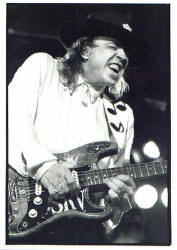 I thought all you folks who read my blog would enjoy checking out a lesson on blues turnarounds I taught my Blues Workshop students today. Included are mp3’s of each turnaround—just click “Listen.”
I thought all you folks who read my blog would enjoy checking out a lesson on blues turnarounds I taught my Blues Workshop students today. Included are mp3’s of each turnaround—just click “Listen.”
Turnarounds, typically played during the last two measures of a blues progression, give the cycle an emphatic ending, and signal that they you’re about to head back to the beginning of the progression again (hence the name). A well-executed turnaround really makes you sound like you know what you’re doing. Drill them into your muscle memory until you can do it in your sleep (as you can see, I’ve been playing the blues in my sleep quite a bit lately).
Though I’ve written these in the keys of A and E, most of these turnarounds are moveable. To move them to a different key, identify your locator note. This note should match the note your key is named after. So if you’re playing in the key of G, and your locator note is on the first string, you’ll play that note on the first string, 3rd fret (which is a G note). Now shift the rest of the pattern to fit that new position.
Key of A
1. First part is moveable. The note on the 1st string at the beginning of the 2nd measure is your locator note.
Listen

2. First part is moveable. Note on 1st string is your locator note.
Listen
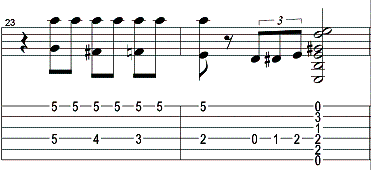
3. Moveable. First note is your locator note.
Listen

4. First part is moveable–the first note is your locator note. Then you have to slide up five frets to start the rest of the lick.
Listen
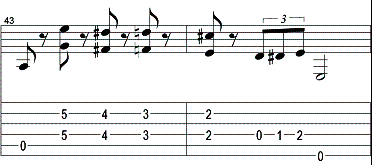
5. Moveable–just change the chords to fit your key (chord in first measure is a I chord, and chord in second measure is a V chord). Note on 1st string, 5th fret is locator note.
Listen
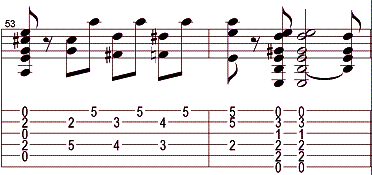
Key of E
1. Easy to move if you change chords to fit the new key. Locator note is a whole step (2 frets) higher than the 2nd string note.
Listen
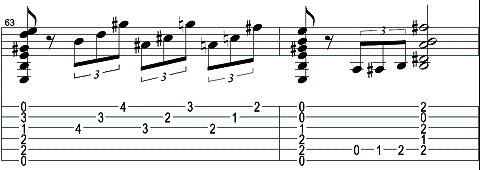
2. Not moveable.
Listen


Comments 32
Rob,
Cool blog, I will definately check it out often. Of all the areas that I have problems (and there are many)the blues turnaround is one that for some reason I can’t get into my head.
great website…you’re the best
Nice Blog. Will be getting down to business with these turnarounds first thing tonight. Do you have any suggestion for playing chords through a blues turnaround as I would like to see those too.
Australia
very cool website…maybe someday i can play the blues just a fraction as well as stevie ray did.
Great basics!! I think you made a quick ref. to endings, but it bears mentioning again that just as these turn arounds go to the V, the same turn arounds can go to the I to end the tune.
great site, man. This page really helped me get a feel for those pesky turnarounds. keep up the righteous work, brother!
I like that you included the MP3’s, that really helps. One can look at tab all day long but it doesn’t convey the tempo rhythm or the feeling of what is supposed to sound like, and the feeling is all important.
I thank you
thanks so much for these. I have marked them as favorites
Many thanks – these are just what I was looking for…Will commit them to memory as quickly as possible!
Thank you! This is awesome! I’ve downloaded the graphics to keep on my laptop at all times! Thanks again.
I’ve been playing guitar for about 2 years and have searched through hundreds of sites, and yours is by far the best! Thanks for the help.
thank you i been wanting to play this song forever. this has really help
Hi – thanks for these – I just bought a good book on blues turnarounds but these are even better! Let’s have some more.
Excellent, just what I was searching for will be learning these tonight
thank you for these, good lesson.
Regards from Spain.
I feel like you’ve given me the knowledge of the universe, thanks so much for these invaluable lessons.
Stuart UK
Excellent! Thank you.
Thanks!
Great blues turnarounds. It really helps a lot.
Love playing them on my yamaha acoustic.
Would like to also to play chords throught blues turnarounds. Any suggestions?
Jmaes UK
Author
Hi James,
In 12-bar blues, play the I chord through the 11th and first part of the 12th measures. On the “and of 2” in the 12th measure, switch to the V chord.
That’s the most common way to do it, anyway.
Hope that helps,
Rob
the fourth turnaround in A:
Is the locator note supposed to be a G? I am confused because it appears as though the first part of the turnaround is descending from a G, instead of an A?
Author
Ned, thanks so much for catching this mistake. I’m mortified I’ve been confusing people since 2006!
I’ve edited turnaround #4–it should be clear now.
Rob
No worries Rob, an easily overlooked mistake. I was changing keys and it just didn’t sound right. Thanks for clearing it up.
Love the turnarounds and your site. Keep it up.
-ned
Glad you’re digging the site, Ned.
Hi Rob, RE your post to James Williams is this what you are saying should be done. I also could never figure out the last part. Peace to you mate, and many thanks.
Stuart
(I) 1+2+3+4+ (IV) 2+2+3+4+ (I) 3+2+3+4+ (I)4+2+3+4+
(IV)5+2+3+4+ (IV) 6+2+3+4+ (I) 7+2+3+4+ (I)8+2+3+4+
(V) 9+2+3+4+ (IV)10+2+3+4+ (I)11+2+3+4+ (I)12+2+(V)3+4+
( Turnaround…………….)
Hi Rob, I dont know what went wrong with the post i just sent but the turnaround was supposed to be on the 11 and 12 bars sorry about that.
Peace,
Stuart
Just what I have been looking for.
Merci. Simples ,efficaces et indispensables.
I just played a 3 chord (A, D, and E)12 bar blues pattern and did the first turnaround at the end of it. It’s beautiful. I understand now.
Author
Awesome, Russ! It really ties things up, doesn’t it?
Thanks Rob
I could use another 50 or so turn-arounds like this! Absolutely great stuff!